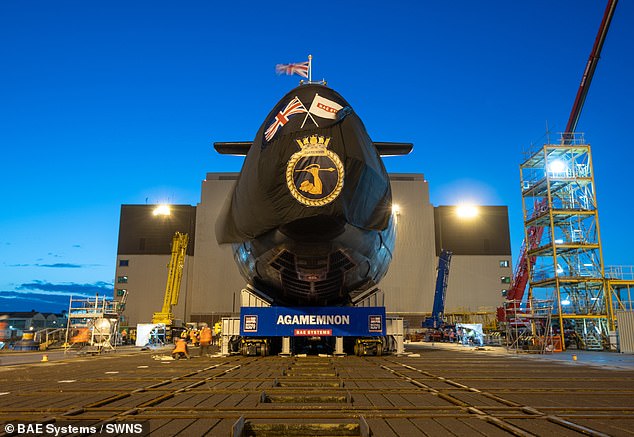[ad_1]
HMS Agamemnon sits in the open dock as workers add finishing touches to the latest Astute Class submarine to roll off production lines at Barrow-in-Furness.
Completion of the sixth of a seven-boat order begun in 2001 might, in years gone by, have been followed by the town’s shipyard facing a contract drought and winding down.
But its fortunes are now different – with a full order book for decades to come, bringing investment and prosperity to an isolated corner of Cumbria.
Rising fears of global conflict mean billions of pounds of orders from the Royal Navy for shipyard owner BAE Systems.
Four Dreadnought submarines will eventually replace the Vanguard class vessels that carry Britain’s Trident nuclear weapons. The Government has also placed an order for up to 12 nuclear-powered Aukus attack submarines.
As a result, BAE is upping its workforce at Barrow-in-Furness from 11,000 to 17,000 – on a par with the shipyard’s historic peak – and is near-trebling its apprenticeship programme to 1,000.

Now hiring: Barrow’s dockyard has orders for decades to come
And a £220 million investment in infrastructure over the next ten years, awarded by Rishi Sunak’s government, is seeing benefits with improvements to the A595, Barrow’s link to the M6.
Barrow’s population of 67,000 has grown for the first time in nearly 40 years, with newcomers attracted by the stunning coastline and Lake District. On a recent visit accompanied by Defence Secretary John Healey, Prime Minister Keir Starmer described its renaissance as a ‘blueprint for the nation’.
Leading BAE’s training at its £25 million submarine Academy For Skills And Knowledge, which opened in 2018, is Jim Perks.
The former submarine captain said: ‘We’ve known for years the Government’s requirement for submarines is growing. We needed to increase our workforce dramatically, increase the size of the yard and improve the supply chain.’
He said the company adopted a ‘grow your own’ approach, recruiting via the academy, which is expanding with a high-tech training hub in the Debenhams store, which closed in 2021. Perks said the hub would allow apprentices to learn techniques on simulators so they can be ‘up to speed’ before joining teams on real boats.
Recruits are a 60:40 split of trade versus degree apprentices, and demand is high with 4,000 applicants in 2024 and 6,000 this year.
While there is a tradition of generations of Barrow families working at the shipyard, Perks, who is also recruiting more women, said: ‘Some of the most complex machines in the world are made here by Barrovians, but we want to look further afield too.’
Carrie, 20, a trainee electrician following in her father’s footsteps, said: ‘I wanted a hands-on job and was always interested in engineering and carrying on the tradition.’
Olivia, 19, training to be a joiner, said: ‘I think it’s good for the town as there’s not been too much to offer around here. It’s particularly helpful for young people. It’s a good start in life with job security.’
Local traders are starting to see an upturn after years of decline. Ashley Holroyd, 33, owner of Coffee D’Ash, opened a branch next to the hub last year having previously sold his drinks from a trailer.
He now employs eight staff, and said: ‘I came to Barrow in 2017 when the shops were closing and footfall was close to dead.’ Pointing to the smartened-up town centre, he added that it now ‘feels like a town on the up’.
BAE’s investment in Barrow is mirrored on the Clyde in Glasgow, where it is building eight Royal Navy Type 26 destroyers. The firm has invested £12 million in an academy – opened by Princess Anne in April – to train 300 recruits annually for the sites at Govan and Scotstoun.
Referring to the threat posed by Russia, vice-admiral Sir Simon Lister, managing director of BAE’s Navy Ships business, who spent over 40 years in the Royal Navy and was briefly British Naval attache in Moscow, said: ‘Over 48 years in the Armed Forces and in the military and defence industry, I’d say this is the most tense and challenging time for us all.’ BAE has also invested £300 million in production facilities at Glasgow to cut the time it takes to build each £1 billion destroyer by a third, from 98 months to 66.
This includes opening a giant shipbuilding hall, allowing two warships to be assembled at once under cover rather than being built in sections before being joined together under scaffolding.
Among apprentices at BAE’s Glasgow academy is Anna, 30.
She said almost ‘every male member of my family’ had worked in the yards or on ships.
She added: ‘My dad served in the Royal Navy, my grandad was in the Royal Naval Reserve and my great grandad, Edward McKnight, was a chief engineer for the Royal Navy. I’m following in my family’s footsteps.’
DIY INVESTING PLATFORMS

AJ Bell

AJ Bell
Easy investing and ready-made portfolios

Hargreaves Lansdown

Hargreaves Lansdown
Free fund dealing and investment ideas

interactive investor

interactive investor
Flat-fee investing from £4.99 per month

InvestEngine

InvestEngine
Account and trading fee-free ETF investing
Trading 212
Trading 212
Free share dealing and no account fee
Affiliate links: If you take out a product This is Money may earn a commission. These deals are chosen by our editorial team, as we think they are worth highlighting. This does not affect our editorial independence.
[ad_2]
This article was originally published by a www.dailymail.co.uk . Read the Original article here. .

